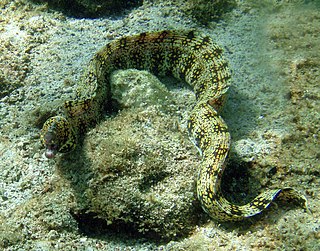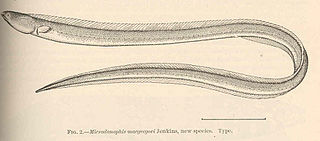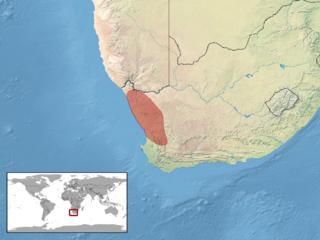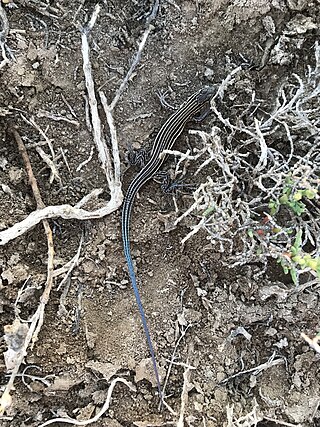
Ophichthidae is a family of fish in the order Anguilliformes, commonly known as the snake eels. The term "Ophichthidae" comes from Greek ophis ("serpent") and ichthys ("fish"). Snake eels are also burrowing eels. They are named for their physical appearance, as they have long, cylindrical, snake-like bodies. This family is found worldwide in tropical to warm temperate waters. They inhabit a wide range of habitats, from coastal shallows and even rivers, to depths below 800 m (2,600 ft). Most species are bottom dwellers, hiding in mud or sand to capture their prey of crustaceans and small fish, but some are pelagic.

Leptodactylus fragilis, known under many common names such as the Mexican white-lipped frog, American white-lipped frog or simply white-lipped frog, is a species of leptodactylid frog. Its distribution ranges from the Lower Rio Grande Valley of Texas in the United States south through Mexico and Central America to Colombia and Venezuela. It is often—wrongly—referred to as Leptodactylus labialis(Cope, 1878), which is a junior synonym of Leptodactylus mystacinus.

The New Zealand longfin eel, also known as ōrea, is a species of freshwater eel that is endemic to New Zealand. It is the largest freshwater eel in New Zealand and the only endemic species – the other eels found in New Zealand are the native shortfin eel, also found in Australia, and the naturally introduced Australian longfin eel. Longfin eels are long-lived, migrating to the Pacific Ocean near Tonga to breed at the end of their lives. They are good climbers as juveniles and so are found in streams and lakes a long way inland. An important traditional food source for Māori, who name them ōrea, longfin eel numbers are declining and they are classified as endangered, but over one hundred tonnes are still commercially fished each year.

The snowflake moray, also known as the clouded moray among many vernacular names, is a species of marine eel of the family Muraenidae. It has blunt teeth ideal for its diet of crustaceans, a trait it shares with the zebra moray.

Dendropsophus molitor is a species of frog in the family Hylidae, known commonly as the green dotted treefrog. It is endemic to Colombia. Its natural habitats are subtropical or tropical high-altitude shrubland, subtropical or tropical high-altitude grassland, shrub-dominated wetlands, swamps, freshwater marshes, intermittent freshwater marshes, pastureland, plantations, rural gardens, urban areas, irrigated land, and seasonally flooded agricultural land.

The striped-tailed delma or single-striped delma is a species of lizard in the Pygopodidae family endemic to Australia.

Eels are ray-finned fish belonging to the order Anguilliformes, which consists of eight suborders, 20 families, 164 genera, and about 1000 species. Eels undergo considerable development from the early larval stage to the eventual adult stage and are usually predators.

Chalcorana labialis, also known as the white-lipped frog, is a species of "true frog" in the family Ranidae. As currently known, it is endemic to Peninsular Malaysia, although it might also occur in Singapore. Molecular data suggest presence of three distinct lineages in the same area, one of which is not closely related to Chalcorana labialis and which could represent an unnamed species.

Protanguilla palau is a species of eel, the only species in the genus Protanguilla, which is in turn the only genus in its family, Protanguillidae. Its common name is Palauan primitive cave eel. Individuals were found swimming in March 2010 in a deep underwater cave in a fringing reef off the coast of Palau.

Eels are elongated fish, ranging in length from five centimetres (2 in) to four metres (13 ft). Adults range in weight from 30 grams to over 25 kilograms. They possess no pelvic fins, and many species also lack pectoral fins. The dorsal and anal fins are fused with the caudal or tail fin, forming a single ribbon running along much of the length of the animal. Most eels live in the shallow waters of the ocean and burrow into sand, mud, or amongst rocks. A majority of eel species are nocturnal and thus are rarely seen. Sometimes, they are seen living together in holes, or "eel pits". Some species of eels live in deeper water on the continental shelves and over the slopes deep as 4,000 metres (13,000 ft). Only members of the family Anguillidae regularly inhabit fresh water, but they too return to the sea to breed.
The Indo-Pacific shorttail conger, also known as the short-tail conger, is an eel in the family Colocongridae. It was described by Chan William Lai-Yee in 1967. It is a marine, deep-water dwelling eel which is known from the Indo-Pacific, including southern Mozambique, Natal, South Africa, the South China Sea, and eastern Australia. It dwells at a maximum depth of 810 metres (2,660 ft). Males are known to reach a maximum total length of 51 centimetres (20 in).
The Johnston snake eel, also known as the peppered worm eel in Micronesia and Hawaii is an eel in the family Ophichthidae. It was described by Leonard Peter Schultz and Loren Paul Woods in 1949. It is a marine, tropical eel, which is known from the Indo-Pacific region, including the Chagos Islands, Hawaii, the Marquesan Islands, the Society Islands, Australia, and New Caledonia. It dwells at a depth range of 2–23 m, and inhabits sand sediments in coral reefs. It can reach a maximum total length of 35 cm.
Scolecenchelys chilensis is an eel in the family Ophichthidae. It was described by John E. McCosker in 1970, originally under the genus Muraenichthys. It is a marine, subtropical eel which is known from Desventuradas Island and Juan Fernández Island, in the southeastern Pacific Ocean. It inhabits sand and debris found in between crevices and rocks. Males can reach a maximum standard length of 28.4 centimetres (11.2 in).
Callechelys catostoma, the black-striped snake eel or dark band snake eel,) is an eel in the family Ophichthidae. It was described by Johann Gottlob Theaenus Schneider and Johann Reinhold Forster in 1801. It is a tropical, marine eel which is known from the Indo-Pacific, including the Red Sea, East Africa, the Society Islands, the Ryukyu Islands, and Lord Howe Island. It dwells at a depth range of 1–32 metres, and inhabits reefs. It burrows into loose gravel and sand. Males can reach a maximum total length of 85 centimetres (33 in).

The fringelip snake-eel is an eel in the family Ophichthidae. It was described by Albert Günther in 1870. It is a marine, tropical eel which is known from the Indo-Pacific, including Zanzibar, Tanzania, Kosi Bay, South Africa, and the Hawaiian Islands. Its lifestyle is mostly benthic but it sometimes swims at the surface. It is olive brown in colour, with lighter colouring in the ventral region. Males can reach a maximum total length of 39 centimetres (15 in).
Astroblepus labialis is a species of catfish of the family Astroblepidae. It can be found on the Marañón River in Peru.

Pachydactylus labialis, commonly known as the Calvinia thick-toed gecko, Western Cape gecko, or Western Cape thick-toed gecko, is a gecko species endemic to the Western and Northern Cape in South Africa, often found taking shelter under stones.

The southern sandslider is a species of skink or Scincidae. The species is endemic to Australia and widespread across the continent, being most commonly found within sandy termite mounds. This is where they take safe refuge from the harsh Australian climate and various ground predators.

Lepidodactylus labialis, also known as the Mindanao false gecko or dark-spotted smooth-scaled gecko, is a species of gecko. It is endemic to the Philippines. It is sometimes placed in the genus Pseudogekko.

The Baja California whiptail is a species of teiid lizard endemic to the Baja California Peninsula in Mexico.















